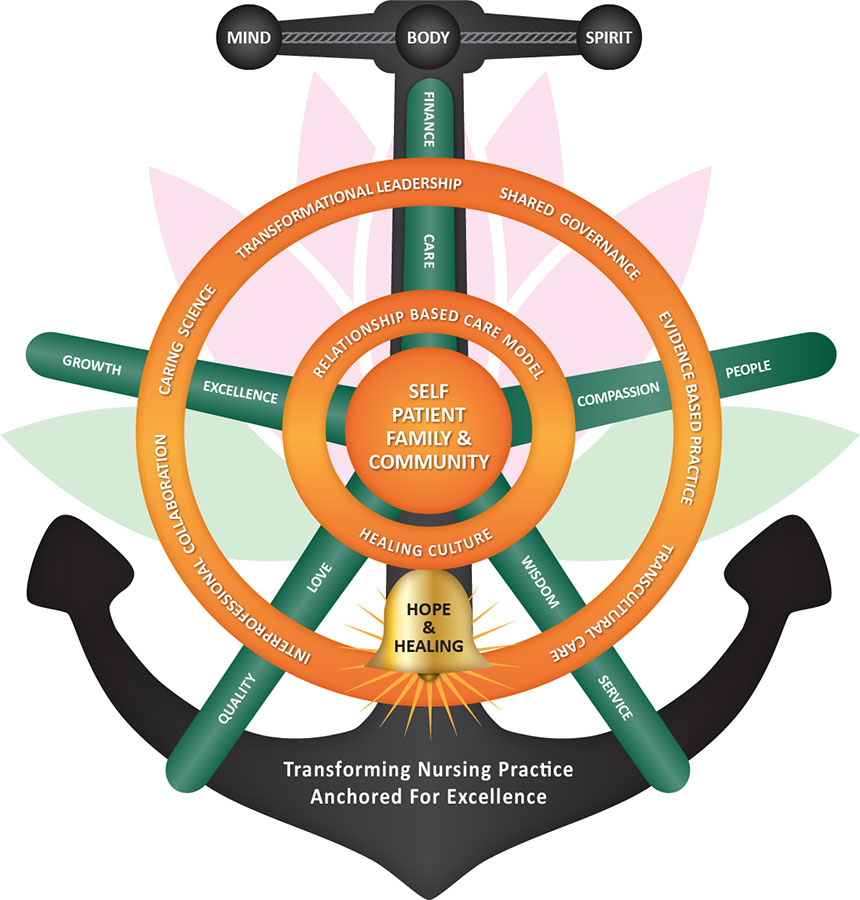
What is a professional practice model?
A professional practice model is the overarching framework for nurses that describes how registered nurses practice, collaborate, communicate and develop professionally to provide high-quality care. It defines what is important to nurses and drives current and future nursing practice at UHealth.
Why do we need a professional practice model?
- To ensure that consistency is maintained in the professional practice of nursing throughout the organization, regardless of the unit, setting or functional role of the nurse (i.e., direct care, charge nurse, nurse specialist, manager, researcher, nurse practitioner).
- To promote continuity, consistency, and a common way of describing and understanding, regardless of practice setting.
- To describe the basic principles of our professional nursing practice.
The framework of our professional practice model guides the nursing strategic plan by:
- Recognizing our core values, mission and vision.
- Defining the components of nursing practice in the delivery of nursing care.
- Supporting nurse-driven delivery of patient care through shared governance and active participation in unit-based and systemwide professional practice councils (Core Councils).
- Identifying the nursing theories that provide structure for decisions and practice for the professional nurse.
- By maintaining the professional practice model, we achieve optimal patient outcomes and pillars of excellence.
Professional Practice Model – What Does it All Mean?
The Anchor and the Helm/Wheel
The UHealth professional practice model, as depicted by an anchor and ship’s helm/wheel, is the schematic representation of the framework for patient care, nursing practice and relationships. The anchor represents our theme, “Anchored to Excellence,” and reflects a practice environment built on a foundation of shared governance.
The professional practice model provides a blueprint for the delivery of patient care and illustrates the alignment and integration of nursing practice with the mission, vision, philosophy and values of nursing at UHealth and the elements include:
- The self, patients, families and community
- Relationship-based nursing care
- Healing culture
- Bell of hope and healing
- Professional values of care, compassion, wisdom, love and excellence
- Nursing theories
- Transformational leadership
- Shared governance
- Evidence-based practice
- Interprofessional collaboration
- Pillars of excellence
- Mind, body and spirit
- Lotus representing Watson’s Theory of Human Caring
- Anchor of Excellence

The center of the wheel represents the focus of our care of self, the patient, family and community. The wheel has a stable center connecting to multiple spokes.
The inner spokes depict our core values: care, compassion, wisdom, love and excellence. The delivery of compassionate, evidence-based patient care enhances the professional status for nurses, improves communication between nurses and other health care colleagues and guides the hospital’s research and educational goals.
The smaller circle represents how the care is delivered through relationship-based care and promotes a healing culture.
The larger circle represents the nursing theories and models that provide structure for decisions and practice, provides nurses with clarity of purpose and strengthens professional identity:
- Transformational Leadership
- Shared Governance
- Evidence-Based Practice — promotes the collection interpretation and integration of valid, important and applicable patient-reported, clinician-observed and research-derived evidence
- Madeleine Leininger — Transcultural Nursing Care Theory
- Interprofessional Care model is an evidence-based approach for integrating health services
- Jean Watson — Theory of Human Caring
The outside spokes represent the pillars of excellence:
- People
- Service
- Finance
- Quality
- Growth